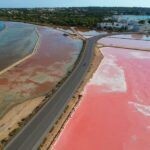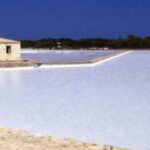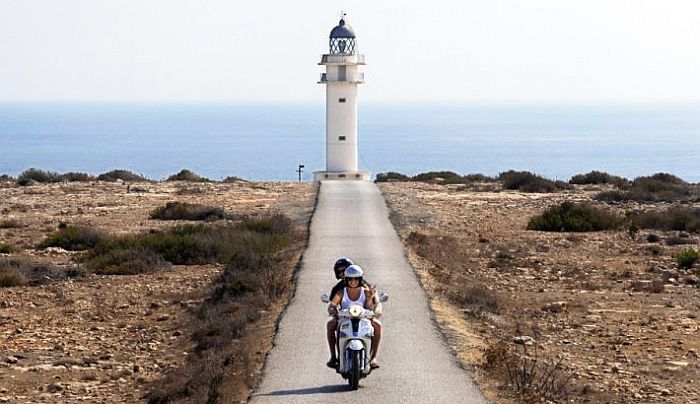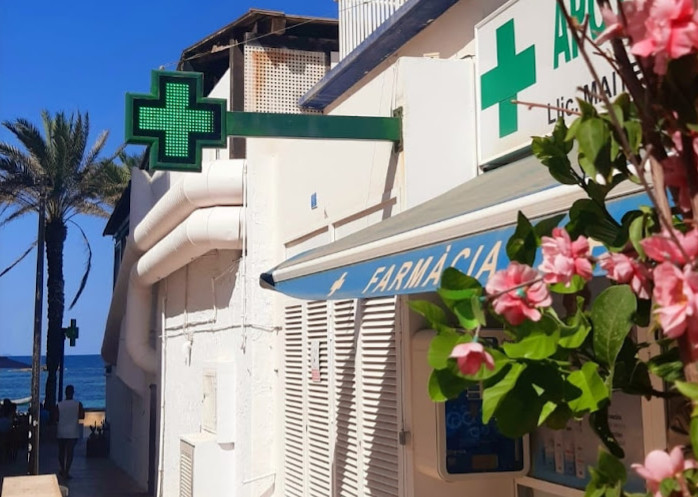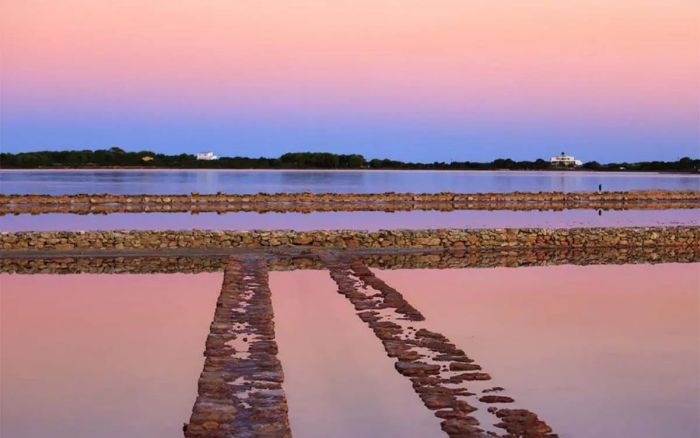
The salt flats of Formentera
The history of the salt flats of Formentera has its roots in a very distant time, but the scarcity of documentation that attests to the veracity of some news prevents its use. We certainly know that salt is the oldest condiment in human history: essential because it allowed some raw materials to be preserved.
To begin to speak of certain events, therefore, the few testimonies about the use of the salt flats of the islands date back to 1200. At the time, Guillermo de Montgrí, an ecclesiastic belonging to the Crown of Aragon, was commissioned by James I of Aragon to conquer Ibiza and Formentera. In 1235, the year in which the capture took place, the salt flats were active and the profits were divided between Montgrí and his two vassals, Pedro de Portugal and Nuño Sánchez de Rosellón.
After that, the history and exploitation of the salt marshes are lost in the centuries. To have certain testimony again, we must arrive at the date of November 14, 1878, the year in which the Fabrica de Sal de Ibiza company was born, which began the trade of the so-called “white gold”. Subsequently, in 1898, Salinera Española absorbed Fábrica de Sal de Ibiza and acquired the rights to use the salt marshes of Formentera.
It was during these years that a process of modernization of the salt industry began. Rails were built, where steam locomotives could run, capable of reaching the port of La Savina, and most of the male population of the island found employment right here. The salt, once it reached the port, was transported to La Mola, where there was a much larger boat bound for Barcelona.
The locomotives used to transport salt are documented until the 1950s, but unfortunately there is no longer any visible trace of them. Only years ago, it was possible to admire a locomotive on display outside the ethnographic museum of Sant Francesc. Finally, we know for sure that the salt extraction activity ended definitively in 1983.
The nature reserve
In 1995, the salt flats, which are located on the north side of the island of Formentera, were declared a Nature Reserve. This designation also includes the salt flats of Ibiza and the islets between the two islands (Espalmador, Es Penjats, Illa des Porcs, Illa de Castelví and others).
In particular, on Formentera, the salt flats area also includes two saltwater lagoons, Estany des Peix and Estany Pudent.
The Parc Natural de Ses Salines de Ibiza y Formentera boasts a total of 2,838.44 hectares of land and approximately 13,000 hectares of sea. This means a lot from the point of view of biodiversity: the salt flats are in fact a natural nesting and stopping point for many species of migratory birds.
The particular habitat that has developed in these areas is worthy of international attention precisely because of its uniqueness. The very important ecological, landscape and cultural value makes the salt flats of Formentera and Ibiza one of the most popular tourist attractions.
The existing habitats
The terrestrial habitat that has developed in the park is home to around 178 plant species, including some that are widespread on the island, such as maritime pines and savin junipers. Another endemic species that can be observed, common near lagoons and water sources, is sea fennel.
The marine environment, which occupies 75% of the park, is characterized by the presence of underwater meadows of Posidonia Oceanica. This plant, which has roots, stems and leaves and is not to be confused with an alga, represents an incalculable wealth for the territory in which it grows: thanks to its conformation, it consolidates the seabed and prevents soil erosion. No less important is the fact that it provides a considerable amount of oxygen to the waters.
In this regard, a news item dating back to 2012, testifies to the oldest Posidonia Oceanica meadow off the coast of Ibiza and Formentera. Discovered by a group of researchers from the University of Algarve, it is 15 km long and weighs 6000 tons. From the various studies carried out, it would appear to be the oldest living organism in the world: an age of between 80,000 and 200,000 years has been mentioned.
In 1999, Posidonia Oceanica was declared a World Heritage Site by UNESCO.
Fauna
The fauna present in the park is particularly rich in birds, with around 210 species counted. Among the best known are the flamingos, the Eurasian hoopoe, the Italian knight and the gulls. This presence is due to the particular position occupied by the island: located between Europe and Africa, it is situated along the main migratory routes.
Numerous species, fleeing from harsh climates, find shelter, or simply stop over, in this area that is well suited both for nesting and as an intermediate stop on journeys with more distant destinations.
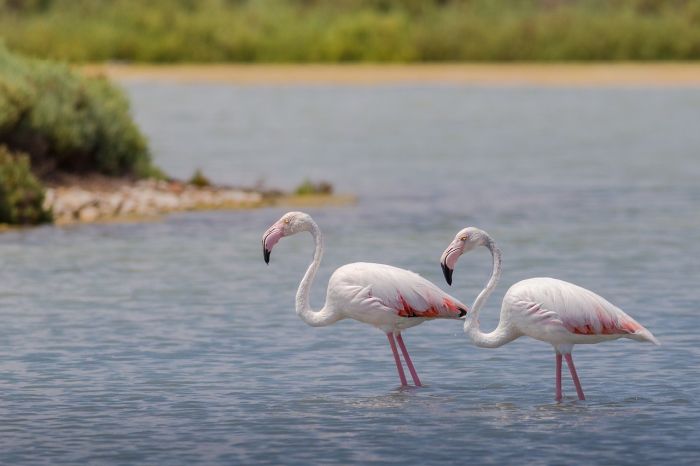
The beauty of this environment and its fauna is that it does not require any special means to be explored. Walking along the Es Brolls path, which runs alongside the Estany Pudent lagoon, you can observe different species of waterfowl, waders or herons. If you want to be sure to observe most of the migratory species, go in spring or autumn, as these are the periods when they migrate.
Finally, the best-known animal species, as well as one of the symbols of the island, is undoubtedly the Pitiusa lizard. This small reptile equally inhabits both the wet area of the salt flats and the rugged rocks of the La Mola plateau.
Il panorama che ne risulta non può che essere altamente suggestivo. Le ore migliori per ammirare i bacini delle saline ed il lago salato di Estany Pudent sono sicuramente quelle che ci accompagnano verso il tramonto. Una passeggiata a piedi oppure in bicicletta vi farà godere di uno spettacolo indimenticabile.
When to admire them
The salt flats of Formentera can be visited all year round as they are an integral part of the territory. However, if you want to see them at the time when a particular pink coloration makes them decidedly scenic, you should go in late summer. It is at this time that the salt crystallizes and the basins, illuminated by the sun, recreate atmospheres worthy of an Impressionist painting.
The resulting panorama cannot but be highly suggestive. The best time to admire the salt flats and the salt lake of Estany Pudent are undoubtedly those that accompany us towards sunset. A walk or a bike ride will allow you to enjoy an unforgettable show.
Salt Flats Today
The activity of the salt flats of Formentera, once so flourishing and essential, definitively ended in 1983. However, in 2008, the activity resumed, albeit in different terms.
A well-known Belgian company produces a liquid salt, from Formentera, which contains a very low percentage of sodium, only 8%. The great innovation of this product lies not only in its presentation, no longer solid but liquid, but also in the fact of being able to taste dishes rich in flavor while avoiding all the risks of an excessive intake of sodium.
The packaging of the Formentera liquid salt is in fact a spray bottle, captivating in style but also for the food innovation it entails. If you want to learn more about this topic, visit their website.
Finally, if you are curious to hear some testimonies about the salt flats of Formentera, you can watch an interesting documentary, unfortunately only available in Catalan. Produced by the journalist Carmelo Covalia, the 50-minute film features some of the people who worked in the salt flats at the beginning of the 20th century.
In 2005, the salt flats of Formentera were declared a Cultural Interest Site.
Formentera Salt Flats Gallery
- Salt flats view from the drone
- View of the salt flats
- Vintage saltworks photo










